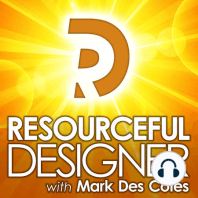37 min listen

Client Onboarding: Part 4 – The Design Proposal – RD163
FromResourceful Designer: Strategies for running a graphic design business
Client Onboarding: Part 4 – The Design Proposal – RD163
FromResourceful Designer: Strategies for running a graphic design business
ratings:
Length:
32 minutes
Released:
May 6, 2019
Format:
Podcast episode
Description
Continuing the client onboarding process with the design proposal. Part 4 of the Client Onboarding Process is the Design Proposal. A tool you use to convince clients that you are the designer for their project. Last week I told you all about the Client Meeting. The part in the process where you learn about the client and about the project they are presenting to you. After a successful client meeting, you should know whether or not you want to take them on as a client and tackle their design project. You should also have a good feel for whether or not the client is inclined to hire you. The client onboarding process is all about finding the right clients that fit your business and goals. If after the client meeting you’ve decided you're not a good fit, then there’s no need for a proposal. Simply thank the client for considering you and inform them that you are not the right person for their project. However, if you think you are a good fit, and you would like to work on their design project, the next step is the proposal. Is a design proposal required Before I dive any further into design proposals let me state that unlike and Inro Packet, which is an important advertisement for your services, or the client meeting, which is required in order to figure out what the client needs from you, not every design project merits a design proposal. If you are bidding on a website worth thousands of dollars, it makes sense to create a proposal. However, if a client has an existing logo and they're asking you to design a business card, or they have a powerpoint presentation already done and they just need you to “make it pretty” for them, then there’s no need for a design proposal. Weigh the pros and cons of creating a design proposal against future returns from the project in question. Is it worth spending an hour, 2 hours, 10 hours or more working on your proposal in the hopes of landing a design project? It all depends on the possible returns you will get on that investment. It’s up to you to decide whether or not a design proposal is the proper next step. The Design Proposal Too often, designers, especially freelance designers work without any kind of protecting documents in place, documents outlining the parameters of a design project. Industry statistics suggest that 48%, almost half of all designers don’t protect themselves with a contract. Without any such documents, agreed upon by both the client and designer, what’s to prevent issues such as scope creep or missed payments from happening? Proposals and contracts are a designer’s best friends. Not only do they protect you and establish the groundwork for a smooth project, but they can help you close the deal, and land more design work. Don’t confuse the design proposal with the design contract. A proposal isn’t always required whereas a contract should be. Some designers combine the two but know that a proposal and a contract, although often used together, are in fact two different things. I’m going to talk about the contract in the next episode. What is a design proposal? A design proposal is a document you present to a potential client outlining details pertaining to their particular design project in order to convince them to hire you. The content of the design proposal is generated through the information you acquired during the client meeting. Just like an intro packet, a design proposal isn’t just a tool to present project details, it’s a tool to show off your talents. Create your design proposal in a way that showcases your skills as a designer. It needs to look professional since it’s a representation of you and your brand. Wow the client with your presentation and they’ll be itching to see what you can design for them. Once you’ve created your first design proposal you should be able to reuse its layout for future clients with minimal alterations except of course for the content pertaining to the client and project in question. As a freelancer, a designer running your own b
Released:
May 6, 2019
Format:
Podcast episode
Titles in the series (100)
Ending Relationships With Your Graphic Design Clients - RD021: It was fun while it lasted. Or, maybe it wasn't. Either way, ending relationships with your graphic design clients is part of the job. If you've been at this long enough you've probably come across a client or two that just rubbed you the... by Resourceful Designer: Strategies for running a graphic design business